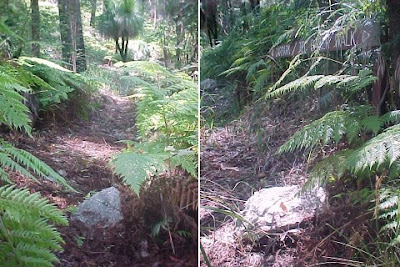
Monday, May 12, 2008
The RTA Intends to Expose Human Lives to these Hazards at Bulahdelah

Thursday, April 24, 2008
Boulders are Already Falling from the Cliffs of the Alum Mountain
Boulders have been falling from the Alum Mountain's cliffs since around the time of commencement of blasting for the NSW Roads and Traffic Authority's (RTA) Pacific Highway Upgrade at Nerong. (Some ten kilometres south of Bulahdelah.)
When the boulders hit the ground they shatter into fragments. The following photographs are of just some of the boulder fragments and trees which have been struck by falling boulders/fragments.
All bar the last of these photo's were taken in the tourism area at the mountain's summit. The last photograph is of a boulder-fragment damaged tree about a quarter of the way down the road from the top carpark.
And the RTA, knowing that boulders from the Alum Mountain's cliffs can reach the their planned Option E roadway area (ref. the RTA document Geotechnical Issues for Community Information - which was not issued to the community) and having been notified that there have been ongoing boulder falls from the mountain's cliffs since the commencement of blasting some ten kilometres south of Bulahdelah, continues to pursue this insanely dangerous route for the Bulahdelah section of the Pacific Highway Upgrade.
The above tree is about a quarter of the way down the road from the Alum Mountain's summit. Fragments of boulders can travel for that distance and more. Prior to recommending the Option E route to (now former) N.S.W. Minister for Roads, Carl Scully, the RTA had documented 'boulders up to six metres in diameter' in the area of the planned roadway (ref. the abovementioned RTA geotechnical document).
Sunday, March 9, 2008
The Bulahdelah Hill - A Trucks Overtaking Trucks Scenario
In addition to exposing road users (and construction workers and residents) to the multiple risks of boulder falls and landslide/s, the route the N.S.W. Roads and Traffic Authority (RTA) is determined to use for the Bulahdelah section of the Pacific Highway Upgrade (Option E) would also have a hill.
That the speed limit for all traffic would lower from 110 km per hour to 100 km per hour at the hill's crest and that northbound laden trucks would be slowed by some 25 km per hour over a distance of 900 metres were recorded in the RTA document Bulahdelah Upgrading the Pacific Highway Environmental Impact Statement (EIS) as areas where the Option E route failed to meet upgrade objectives. However, although it was also recorded in the EIS that southbound laden trucks would be slowed by 20 km per hour over a distance of 1 (one) kilometre, this was not included as an upgrade objective failure.
The slowing of laden trucks would average out at around 22.5 km per hour over almost 2 kilometres. The Option E section of highway, albeit with sufficient width for later widening to six lanes, would initially have only two lanes on each side.
What a scenario: some 2 kilometres of trucks overtaking trucks, all traffic being slowed when this occurs and frustrated drivers galore - and all in a cutting beneath the nearly perpendicular, 40 metres tall cliffs of a 292 metres high mountain long known to be prone to rockfalls, boulder falls and landslides.
Although pre-construction work has commenced on this dangerous route, it is not too late for the safest route for road users - Option A, to the west of Bulahdelah - to be used. Already, massive sections of rock on the Alum Mountain's cliffs are being undermined by ongoing boulder falls which commenced at around the same time as did RTA blasting some ten kilometres south of Bulahdelah.




